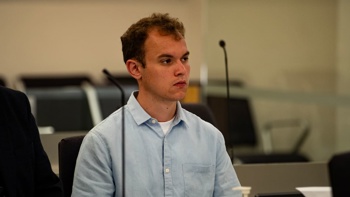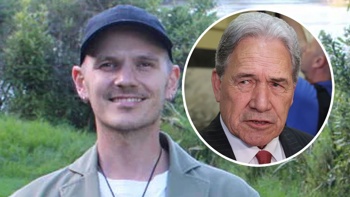- A State of National Emergency has been declared in response to the path of destruction caused by Cyclone Gabrielle across the North Island
- Tens of thousands of homes are without power and entire settlements including Piha and Muriwai - where a firefighter is missing in a landslip - have been cut off
- Napier and other Hawke’s Bay areas have been severely hit by flooding and power outages
- Coromandel has been virtually cut off, with just about every major road impacted
- Cyclone’s latest track, region-by-region warnings, shelter locations and all you need to know
The Prime Minister has labelled Cyclone Gabrielle the “most severe weather event this century” as it continues to cause havoc, knocking out power to 225,000 people around the North Island and displacing 2500 Kiwis from their homes.
The cyclone has left North Island regions devastated by flooding and slips, destroying homes, with a firefighter missing after a landslide at Muriwai, west of Auckland.
Fire and Emergency chief executive Kerry Gregory said crews continued searching the landslide site this afternoon for the missing firefighter.
But crews had now stood down for the night as conditions were not safe to work in the dark.
“We are focused on preparing for the search to resume tomorrow morning. We are doing everything we can to get our missing firefighter, friend, colleague and loved one back in what is a very challenging operation.
“The focus now is on planning for work to restart tomorrow morning with a keen focus on safety given the current conditions at the Muriwai site.”
FENZ was supporting whanau of the affected firefighters and other members of the brigade as the situation remained raw.
Prime Minister Chris Hipkins sent a message to the fire crew responding to the landslide, saying “our thoughts and hopes are with you”.
Hipkins said the impact of Cyclone Gabrielle was significant and widespread and he labelled it the worst weather event this century.
More than 2500 people and families have been displaced from their homes - including 1000 evacuated in the Far North, 400 households in Auckland, 93 in Bay of Plenty, 75 in Waikato, and roughly 1000 people in Hawke’s Bay.
Rescue operations in Hawke’s Bay are underway. In Wairoa, the river has burst its banks, inundating 10-15 per cent of the town which is home to around half of the town’s 8000 population. With no power or phones, the only communication is via satellite phone.
There are very limited supplies of food and water with no drinking water supply due to the flooding.
An RNZAF reconnaissance flight was also to be sent to the northern Hawke’s Bay town, which has been cut off with little to no communication from the area since power, internet, and phone services went down.
“Wairoa, particularly, is of concern,” Emergency Response Minister Kieran McAnulty said about communication with the town.
Close to 225,000 people were without power and Hipkins said electricity companies “haven’t seen this damage since Cyclone Bola” in 1988. Some cell towers were down and others were operating on batteries that could run out.
Forty-one supermarkets are closed, which Hipkins said those were largely in Northland, Gisborne and Hawke’s Bay. “Please only buy what you need,” he said.
The Prime Minister said the country wasn’t out of the woods. “We’re still in for a bumpy time ahead,” he said, while acknowledging that the weather was set to improve overall in the coming days.
Schools across big parts of the North Island remain shut and Hipkins said principals will make the call on when they will open.
Wild winds are still battering the country and Auckland Airport has cancelled domestic and international flight operations for safety reasons.
“High winds have forced the suspension of ground handling operations at Auckland Airport from now until midnight, meaning no international or domestic passenger flights can depart or arrive until tomorrow,” the airport said in a statement.
“Safety comes first at Auckland Airport and given current high winds and the need to ensure the safety of everyone working in and around the airport apron areas, ground handling operators have decided to suspend operations for the rest of the night,” said Auckland Airport Chief Customer Officer Scott Tasker.
Air New Zealand had earlier cancelled all domestic flights in and out of Auckland for the remainder of Tuesday because of strong gusts that have been making it difficult for ground staff to service aircraft.
STORY CONTINUES AFTER LIVE BLOG:
STORY CONTINUES:
Meanwhile, a firefighter trapped by a collapsed house in Auckland’s Muriwai has yet to be found as crews scramble at the scene and evacuate more residents in what officials say is still a “dangerous” cyclone-hit area.
“Our hearts and thoughts are with you,” said Auckland Emergency Management deputy controller Rachel Kelleher as she acknowledged staff at Fire and Emergency searching for their trapped colleague at Muriwai. Emergency services had to make the devastating decision to call off the search for their missing colleague - believed to be local vet Dave van Zwananberg - as the saturated nearby hillside continued to move after torrential rain overnight.
The destruction wrought in Muriwai - where houses collapsed in slips - has followed Cyclone Gabrielle as it travels south, drenching Hawke’s Bay and putting parts of Napier underwater. Many residents were told to “evacuate immediately” earlier today and move to the nearest hill as flooding worsened.
/cloudfront-ap-southeast-2.images.arcpublishing.com/nzme/D55Z6BEXVBBH5IXXFPR77WDUI4.jpeg)
Aerial views of flooding in Hawke's Bay as Cyclone Gabrielle hit the region. Photo / Photography by Corena
/cloudfront-ap-southeast-2.images.arcpublishing.com/nzme/U2GKVP27WNFH5GQTN3KHC5WXY4.jpg)
Extensive flooding at Awatoto seen from above the Napier Golf Course. Photo / Photography by Corena
Near Hastings, workers were standing on the roofs of buildings submerged in floodwaters, waiting to be rescued. The Defence Force helped residents in Napier’s Esk Valley leave their homes - and further north also to get some locals out of Dargaville where a river has burst its banks.
Power is out to tens of thousands around the country - including 44,000 people in Auckland. Transpower has declared a “grid emergency” in parts of Hawke’s Bay, warning it will be “days and weeks” rather than hours before electricity is restored.
The extent of Gabrielle’s devastation led to a national state of emergency being declared - with cut-off communities across the North Island, including on big swathes of the Coromandel and East Coast. Gisborne was without power, internet and phone coverage and main roads both in and out of the region were blocked.
One photo shows a large slip on Matarangi Rd in the Coromandel.
/cloudfront-ap-southeast-2.images.arcpublishing.com/nzme/AH4WKGZEKRB2VDUU3NSWOZQS4Q.jpg)
A slip on Matarangi Rd on the Coromandel. Photo / Thames-Coromandel District Council
The firefighter missing after being caught in a slip in Muriwai, one of the hardest-hit suburbs in Auckland, has yet to be found. An exclusion zone has been set up in Muriwai by police and authorities say it’s of “extreme concern” that people were returning to dangerous areas in the suburb. Shortly before 2pm, an emergency alert was sent to more residents in the area asking them to evacuate.
The volunteer firefighter who is missing was investigating a flooded house on Motutara Rd in Muriwai when a landslide crushed the house and hit a fire truck. A fellow firefighter was rescued and rushed to hospital.
The incident is one of 1800 that authorities have been called to during a cyclone which Prime Minister Chris Hipkins said had caused “extensive damage across the country”.
At first light, advice was provided to McAnulty and Hipkins that a state of emergency should be declared “and we acted immediately”.
“This is only the third time in New Zealand history that a National State of Emergency has been declared,” McAnulty said. ”This is an unprecedented weather event that is having major impacts across much of the North Island.”
At 9.20am Hawke’s Bay Today photographer Warren Buckland said Napier is cut off.
”All bridges are gone or severely compromised.”
More than 40 households in Eskdale in Hawke’s Bay are trapped because of Cyclone Gabrielle, Fire and Emergency NZ told 1News.
Thames-Coromandel Civil Defence controller Garry Towler said his region had “certainly been pummelled”.
”We have lost cell phone coverage in Whangamatā and Tairua and many of our coastal communities north and south of Whitianga, including places like Matarangi and Hahei.
”There’s mass power outages, entire roading networks are closed and there’s widespread flooding.”
McAnulty said the cyclone was a significant disaster with a real threat to the lives of New Zealanders.
Meanwhile, in Taranaki, more than 10,000 people were without power after a wild and windy night.
Wind gusts reached 120km/h in the region this morning leaving widespread debris on roads and damaging trees.
In Gisborne, more than two dozen families sought refuge at a local marae after floodwaters threatened their homes.
Te Akau o Tokomaru Civil Defence coordinator Lilian Te Hau-Ward said 26 families were evacuated to higher ground last night and were now returning to their homes to assess the damage.
On Auckland’s West Coast, Muriwai residents have been evacuated to the local surf club. Piha has been cut-off while residents are without power and water.
Journalist Mary Holm was in the neighbourhood overnight and this morning.
”Horizontal rain was pounding ... the house was shaking and water was coming through the windows, round the edge of aluminium windows,” Holm said.
”At North Piha, right at the northern end, the road is flooded and I talked to a guy who swam through it. It’s chest-deep.”
/cloudfront-ap-southeast-2.images.arcpublishing.com/nzme/IMBURFNERRAEJEMZSJWVDOARLU.jpg)
Residents evacuated from their homes on Normanby Rd, Mt Eden, after the historic Shot Tower was under threat of collapse as Cyclone Gabrielle brought extreme weather to Auckland. Photo / George Heard
/cloudfront-ap-southeast-2.images.arcpublishing.com/nzme/F7RWVS55GFE6ZF7O7DGNIYEVKU.png)
Two people wade through waist-high water after abandoning their car on the road to Hahei on the Coromandel Peninsula. Photo / Matthew Davison
Take your Radio, Podcasts and Music with you









